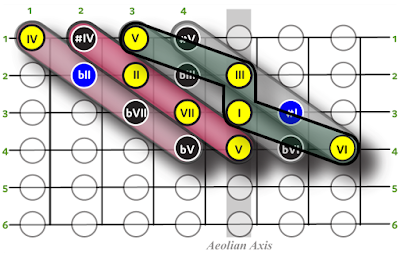Each major key has two major 7th chords; the
I and the
IV. But since these two chords are a fourth or a fifth apart, they are not both found inside the block. How do we determine which of the major 7ths in the block is the I or the IV?
If we place the block so that it aligns with the Center Axis (also referred to as the
Aeolian Axis), then none of the major 7ths are diatonically in the key. However, we have the
minor tonic chord — the minor 7th on VI — flanked by two major 7ths rooted on the V and the bVII. Keep in mind that neither of these major 7ths are diatonic ... that is, they are both outside the key, as are the other two greyed out maj7ths partly hidden beneath the diatonic VI chord.
Now look what happens when the tonic chord is the first column:
... Now we have a diatonic major 7th followed by a diatonic minor 7th. Notice the Dorian Axis where the Aeolian Axis was before, followed by The Void, and the Phrygian Axis positions. Perhaps more importantly is the presence of a major 7th chord related to the minor 7th. Because the minor 7th is preceded by the I, there is clearer diatonic structure in this placement of the block.
There are three minor diatonic minor 7th chords, and two of them are adjacent to a major 7th. The II shown directly above, and the III shown below, which essentially reverses the relationship of the minor and major 7ths:
We can also find a minor 7th rooted on the 4th column, preceded on the 2nd column by the Tonic or the V:
If the minor 7th is a VI and is rooted in the 4th column, there will be no diatonic major 7ths in the block, but the major 7th rooted on the V can be described as "borrowed" from the possible major 7th of the VII of the melodic minor, the #IV of the major mode shown here being the #VI of the minor mode of the key:
... and finally, the minor 7th can be placed on the 2nd column, thus:
Still, if we want to find another symmetry within this block, and we rule out the criterion of maintaining a diatonic major 7th, we can see that the minor 7th chords rooted on II and III fit nicely in the block's boundaries. The four "shadow" major 7th chords have an interesting symmetry as each of them contains two notes of the key, alternating between the 3rd and 7th in column 1, the root and 3rd of column 2, and repeating the same relationships in the next two columns:
The Major 7th chord (or arpeggio) is our primary element in these blocks, so it makes sense that there always be one diatonic major 7th in the block based on the chosen key. The distribution of the major 7ths in a diatonic key means that there can only be one, and not two, maj7ths in any block, but it can be in any of the four positions.
...
Lets now add all the surrounding notes as well as another landmark: The faint grey ellipses indicate the half-step clusters ( VII - I - III - IV ) ... and we'll shift the tonic chord is the 2nd column. The Void position on the fretboard is now aligned with the 2nd and 4th column of the block, rather than the 1st and 3rd.
Also, the VII is shown darker so as to bring out the geometry of the Ionian scale which comprises a whole-step on the 4th string, a half-step on the 3rd string, whole-step on the 2nd string and half-step on the 1st. This scale pattern reveals the symmetry of the two tetrachords nicely. It can be fingered; 2nd finger, 4th, 1st finger, 2nd, 2nd finger 4th, 1st finger 2nd.
As you can see, there is now a half-step cluster (B C E F) in the lower left corner of the block.
If you replace the Roman numerals with note names in the key of C, the geometry of the surrounding notes will of course remain the same. This pattern can be applied to any key until it reaches the end of the fretboard, i.e.; the #VI (which is the 7th of the first column) is eqivalent to E, or the root of the 4th column chord (II) is not above a practical fret position, which will vary depending on the type of guitar you're playing.

These blocks are useful as a way of studying the tonal relationships within keys on the fretboard. Another one of many possibilities is shown next. Here the two major 3rds which share the unison note are called out by short olive-green diagonals. In this case, one is the tonic 3rd and the other comprises the III of the key and its major 3rd which is an accidental, all combining to create an augmented triad on the I, but stretched out across a total span of seven frets. The fingering for this should be simply one finger per string, i.e.: I (4th string) = 4th finger, III (3rd string) = 3rd finger, III (2nd string) = 2nd finger, and #V (1st string) = 1st finger.
... more to come.













































